2004 MERCEDES-BENZ CLK COUPE child seat
[x] Cancel search: child seatPage 49 of 453

46 Safety
Occupant safety
This section
will familiarise you with the
most important features of the restraint
systems inyour vehicle. In the event of an
accident, your vehicle may collide with
another object ,e.g. another vehicle. This
may result in rapid acceleration or deceler-
ation of your vehicle. During this acce lera-
tion or deceleration ,the vehicle occupants
will be moved in the opposite direction to
the force of the impact. Ther eis therefore
the risk of vehicle occupants injuring them-
selves on the vehicle interior or on parts of
the vehicle. The purpose of supplemental
restraint systems – first and foremost the
seat belts supplemen ted where necessary
by belt tensioners, belt force limiters and
airbags – is to minimise this ris kof injury.
However, seat belts and airbag sare gener-
ally unable to prevent injuries caused by
objects pe netrating the vehicle from the
outside. The most important restraint syst
ems are:
�! Seat belts
�! Restraint systems for children, since
they are the most effective means of
reducing the extent to which occu-
pants are moved in the event of an
accident
Additional protection isprovided by:
�! The SRS (S upplementa
l R estraint
S yste
m)comprising:
�! Belt tensioners
�! Belt force limiters
�! Airba gs
�! Roll-over bars (Cabriolet)
i An air bag increases the degree ofprotection
for vehicle occupant swear ingas eat belt and is
therefore to be considered onl yas an additional
re strai ntsystem tothe seat be lt. Airbags are not
a substitute for wearing a seat belt correctl yat
all tim es. This is because, on the one hand, air-
bags are not triggered in all types of accid ent,as
in som esituations the irdeploy mentwould not
increase the protection enjoyed bythe vehicle
occ upants ,provided they are wearing their seat
be lts correct ly. i
And on the other hand, ai rbag deployment
only provid esincreased prote ction if the seat
bel tis worn co rrectly, because:
�! theb elt helps to keep the vehicle occupant
in the best position inrelation to the airbag
�! thebelt protects to a lar geextent the vehicle
oc cupant from bei ngpropelled towards the
force of impact, e.g. in the event of afrontal
collision, and is there fore better able to
reduce the risk ofinjury
In an accident in which anairbag is triggered, its
deployment will only enhanc ethe protectio npro-
vided by the seat belt, if the seat belt isworn cor-
rectly. Occupant safety
Restr
aint syste ms 209en_d2.boo Seite
46Diens tag, 25 .Mai 2004 7:26 19
Page 51 of 453
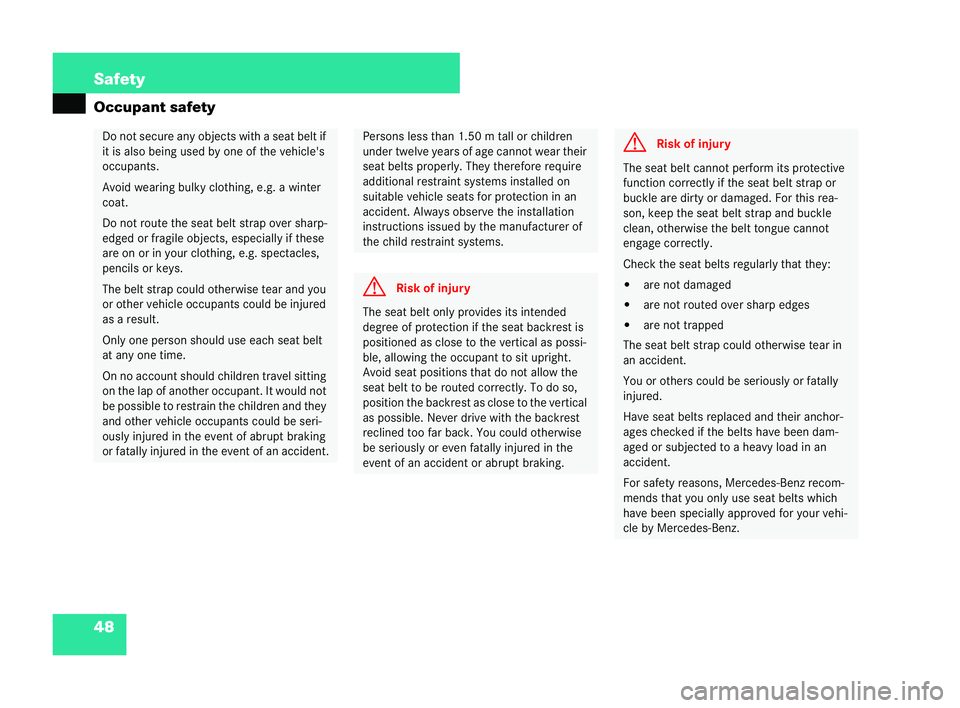
48 Safety
Occupant safety Do not se
cure any object s with a seat belt if
it is also being used by one of the vehi cle's
occupa nts.
Avoid wearing bulky clothing, e.g. a winter
coat.
Do not rout ethe seat belt strap over sharp-
edged or fragile objects, especially if these
ar e on orinyour cl othing, e.g. spectac les,
pencils or keys.
The belt strap could otherwise tear and you
or other vehicl eoccupa nts could be injured
as aresult.
Onl yone person should use each seat belt
at anyo ne time.
On no account should chil dren travel sitting
on the lap of anotheroccupa nt. It wou ldnot
be possible to restrain the children and they
and other vehicle occupan tscou ldbe seri-
ously injured in the event of abrupt braking
or fatally injured in th eevent of an accident. Persons less than 1.50 m
tall or children
un der twelve years of agecannot wear their
seat belts properly. The yth ere fore require
additio nal restraint systems installed on
suitable vehicle seats for protection in an
accident. Always observe the installation
instructions issued by the manufactu rer of
the child re straint systems. G
Risk of injury The seat belt onl
yprovides its intended
degree of protection if the seat bac krest is
positioned as close to the vertical as possi-
ble, allowing the occupant to sit upright.
Avoid seat positions that do not allow the
seat belt to be routed correctly. To do so,
position the backrest as close to th evertical
as possible. Never drive with the backrest
recli ned too far back. You could otherwise
be serio uslyor even fatally injured in the
event of an accident or abrupt bra king. G
Risk ofinjury The seat belt cannot perform its protective
function
correctly if the seat belt strap or
buckle are dirty or damaged. For this rea-
son, keep the seat belt strap and buckle
clean, otherwise the belt tongu eca nnot
engage correctly.
Chec kthe seat belts regularly that they:
�! arenot damag ed
�! are not routed over sharp edges
�! are not trapped
The seat belt strap could oth erwi se tear in
an accident.
Yo u or ot hers could be seriously or fatally
injured.
Have seat belts replaced and their anchor-
ages checked if the belts have been dam-
age dors ubjected to a heavyloa din an
accid ent.
For safety reasons, Mercedes-Benz recom-
mends that you only use seat belts which
have been specially approved for your vehi-
cl e by Mercedes-Be nz.209en_d2.boo Seite
48Diens tag, 25 .Mai 2004 7:26 19
Page 52 of 453
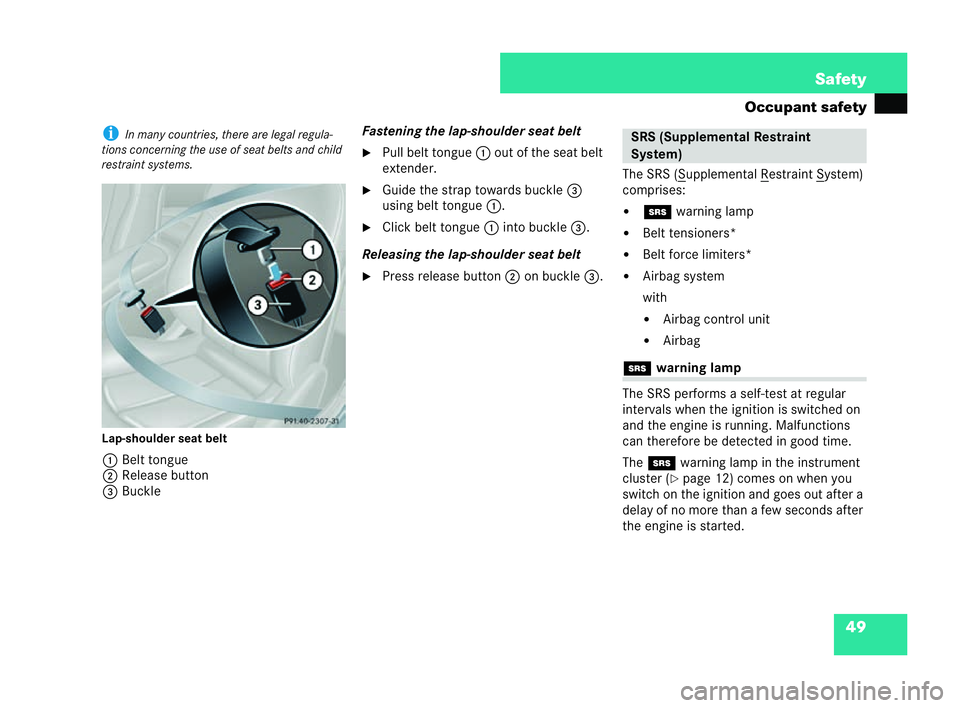
49
Safety
Occupant safety i
Inma nycountries, there are legal regula-
tions concerning th euse of seat belts and child
restraint sys tems.
Lap-shoulder seat belt 1 Belt tongue
2 Release button
3 Buc kle Fastening the lap-shoulder seat belt
�6 Pull bel ttongue 1out of the seat belt
extender.
�6 Guide the strap towards buckle 3
using belt tongue 1.
�6 Click belt tongue 1into buckle 3.
Rel easing the lap-shoulder seat belt
�6 Press release button 2on buck le3 . The
SRS (S upplemental R estraint S ystem)
comprises:
�! 1 warning lamp
�! Belt tensioners*
�! Belt force limiters*
�! Airbag system
with
�! Airbag control unit
�! Airbag 1
warning lamp
The SRS performs a sel f-test at regular
intervals when the ignition is switched on
and the engine is runn ing. Malfunctions
can therefore be detected in good time.
The 1 warning lamp in the instrume nt
cluster ( �=page 12) comes on when you
switch onthe ignition and goes out after a
delay of no more than a few seconds after
the engine is started.
P91.40-2307-31 SRS (Supplemental Restraint
System)209en_d2.boo Seite
49Diens tag, 25 .Mai 2004 7:26 19
Page 56 of 453
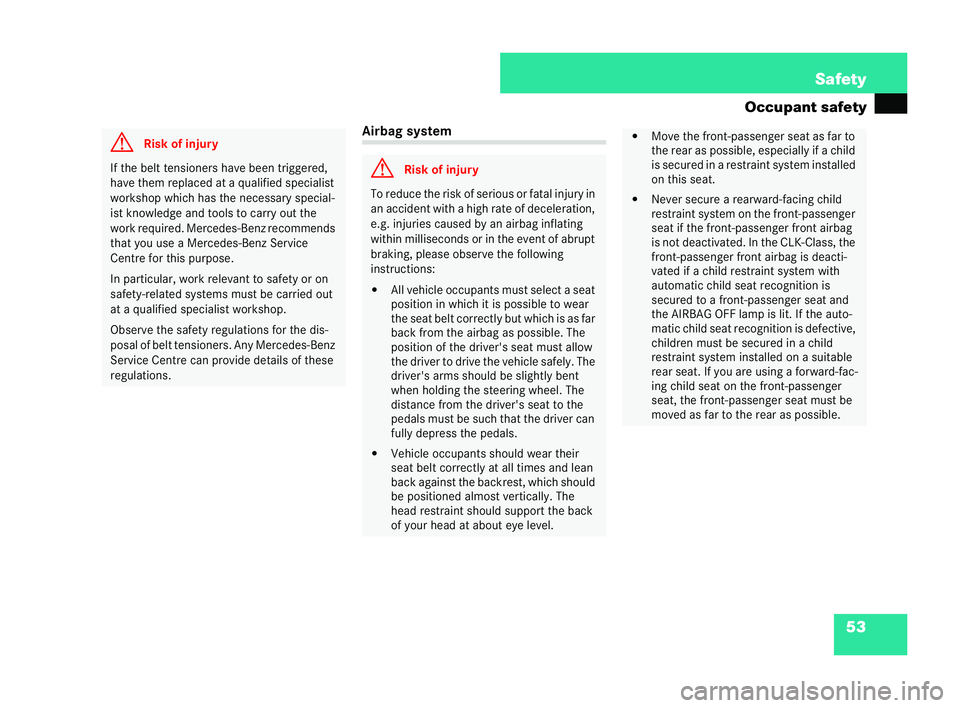
53
Safety
Occupant safety Ai
rb ag syst em G
Risk ofinjury If the belt tensi
onersha ve bee ntriggered,
have them replaced ata qualified specialist
workshop which has th eneces sary special-
ist knowledge and tools to carry out the
work required. Mercedes -Benz recommends
that you use a Mercedes-Be nzService
Centre for this purpose.
In particular, work rele vant to safety or on
safe ty-re lated systems mustbe carried out
at a qualified spec ialist workshop.
Ob serve the safety regulations for th edis-
posal of belt tensioners. Any Mercedes-B enz
Service Centre can provide detail sof these
regulations. G
Risk of injury To reduce the risk of serious or fata
linjury in
an accident with a high rate of deceleration,
e.g. injuries caused by an airbaginflating
within milliseconds or in the ev ent of abrupt
br aking, please observe the following
inst ructions:
�! Allve hicle occupants must select a seat
position in which it is possible to wear
the seat belt correctl ybut which is as far
back from the airba gas possible. The
position of the driver's seat must allow
the driver to drive th evehicle safely. The
driver's arms shou ldbe slightly bent
when holding the steering wheel. The
distance from th edriver's seat to the
pedals must be such that the dr iver can
fully depress the pedals.
�! Vehicle occupants should wear their
seat belt correctly at all times and lean
back against the bac krest, which should
be positioned almost vertically. The
head restraint should support the back
of yo urhead at abo uteye level. �!
Move the front- passenger seat as far to
the rear as possible, especially if a child
is secured in a restraint system installed
on this sea t.
�! Never secure a rearward-facing child
restraint system on the front-pass enger
seat if the front-passenger front airbag
is not deactivate d.In the CLK-Class, the
fr ont-passen ger fro ntairbag is deacti-
vated if a child restraint system with
automatic child seat recognition is
secured to a front-passenger seat and
the AIRBAG OFF lamp is lit. If the auto-
matic child seat rec ognition is defective,
children must be secured in a child
restraint system ins talled on a suitable
re ar seat. If you are using aforward-f ac-
in g child seat on the fro nt-pa ssen ger
seat, the front-passenger seat must be
moved as far to the rear as possibl e. 209en_d2.boo Seite
53Diens tag, 25 .Mai 2004 7:26 19
Page 59 of 453
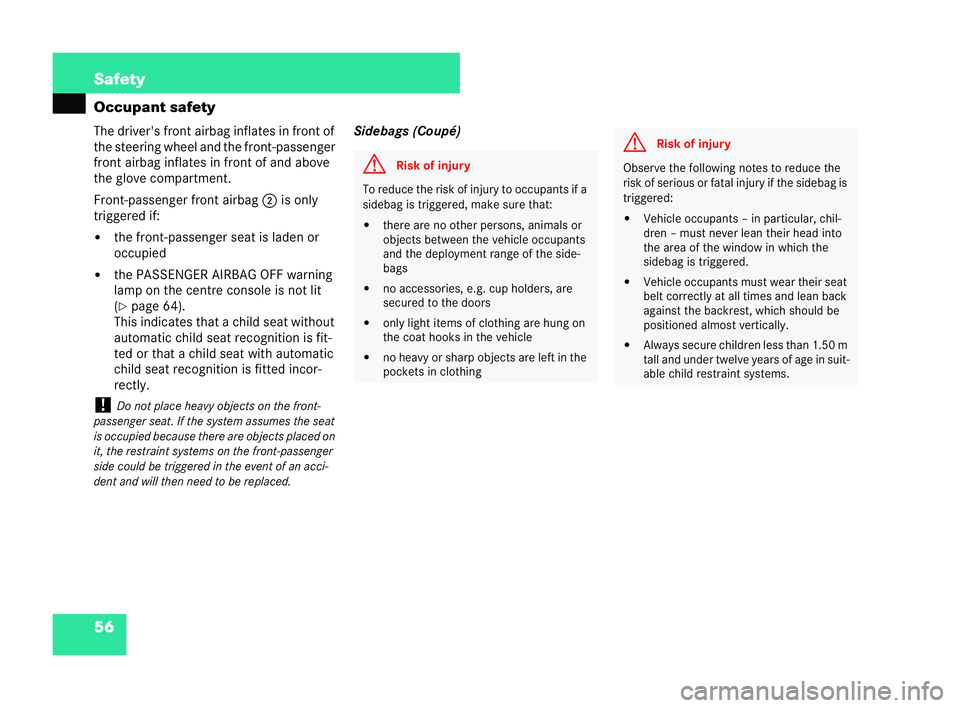
56 Safety
Occupant safety
The driver's front airbag
inflates in front of
the steering wheel and the front-passen ger
front airbag inflates infront of and above
the glove compartment.
Front-passenger front airbag 2ison ly
triggered if:
�! the front-passenger seat is laden or
occupied
�! the PASSENGER AIRBAG OFF wa rning
lamp on the centre console is not lit
(�= page 64).
This indicates that a child seat without
au tomatic child seat rec ognition is fit-
te d or that achild seat wit hautomatic
child seat recognition is fitte dincor-
rec tly.
! Do not place heavy objects onthe front-
pas seng er seat. Ifthe system assumes the seat
is occupied because there are objects placed on
it, the restr aint systems on the front-passe nger
si de could be triggered in the event of an acci-
dent and will then need to be replaced. Sidebags (Coupé) G
Risk of injury To reduce the risk of in
juryto occu pantsif a
sidebag is triggered, make sure that:
�! there are no other persons ,animals or
ob jects between the vehic leoccu pants
and the deployment range of the side-
bags
�! noacce ssories, e.g. cup holders, are
secure dto the doors
�! only lig htitems of clothing are hun gon
the coat hooks in the vehicle
�! no heavy or sharp objec tsare lef tin the
pockets in clo thing G
Risk ofinjury Ob
serve the following notes to reduce the
ris ko f serio usorfatal in jury if the sidebag is
triggered:
�! Vehicle occupants – in particular, chil-
dren – must never lean their head into
the area of the window in which the
sidebag is triggered.
�! Vehicle occupants must wear their seat
belt correctly at all times and lean back
against the backrest, which should be
positioned almost vertically.
�! Always secure children less than 1.50 m
tall and under twelve years of age insuit-
able child restraint systems. 209en_d2.boo Seite
56Diens tag, 25 .Mai 2004 7:26 19
Page 61 of 453
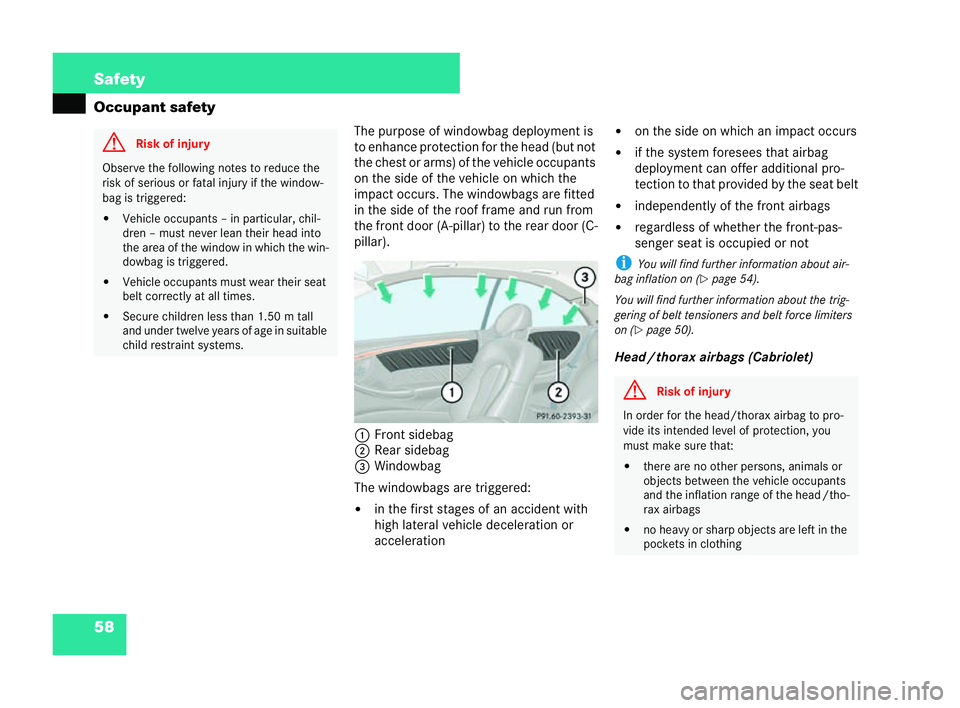
58 Safety
Occupant safety
The purpose of windowbag deployment is
to enhance protection for the head (but not
the chest or arms) of thevehicle occupants
on the side of the vehicle on which the
impact occurs. The windowbags are fitted
in the side of the roof frame and run from
the front door (A-pillar )to the rear door (C-
pillar).
1 Front sidebag
2 Rea rsidebag
3 Windowbag
The windowbags are triggered:
�! in the first stages of an accident with
high lateral vehicle deceleration or
acceleration �!
on the side on which an impact occurs
�! if the system foresees that airbag
deployment can offer additional pro-
tection to that provid edby the seat belt
�! independent lyof the front airbags
�! regardless ofwh ether the front-pas-
senger seat is occupied or not
i You will find further information abo utair-
bag inflation on ( �=
page 54).
You will find fur ther information about the trig-
gering of belt tensioners and bel tforce limiters
on ( �=
pag e50).
Head /tho rax airbags (Cabriolet) G
Risk of inju ry Observe th
efollowing notes to reduce the
risk ofserio us or fatal injury if the window-
bag istriggered:
�! Vehicle occupants – in particular, chil-
dren – must never lean their head into
the area of the window in wh ich the win-
do wbag is triggered.
�! Vehicle occupantsmust wear their seat
be lt correctly at all times.
�! Secure chi ldren less than 1. 50m tall
an d under twelve years of agein suitable
child restraint systems. P91.40-2393-31 G
Risk ofinjury In order for the head/thorax airbag to pro-
vide its intended level of protection, you
must make
sure that:
�! there are no other persons, animals or
obje cts between the vehicle occupan ts
and the inflation range of the head /tho-
rax airbags
�! noheavy or sharp objects are left in the
pockets in clothing 209en_d2.boo Seite
58Diens tag, 25 .Mai 2004 7:26 19
Page 62 of 453
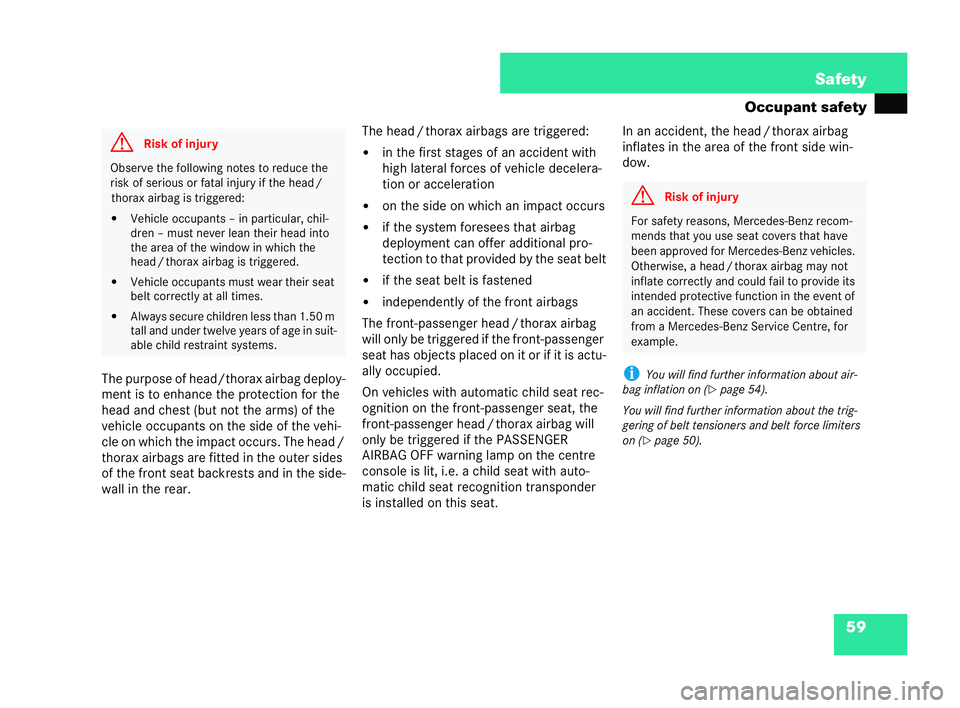
59
Safety
Occupant safety
The purpose of head/thorax airbag deploy-
ment is to enhance the protection for the
he ad and chest (but not the arms)of the
ve hicle occupants on the side of the vehi-
cle on whi chthe impact occurs. The head /
thorax airbags are fitte din the outer sides
of the front seat backrests and in the side-
wall in the rear. Th
e hea d/thor ax airbags are trigger ed:
�! inthe first stages of an accident with
high lateral forces of vehicle decelera-
tion or acceleration
�! on the side on which an impact occurs
�! ifthe system foresees that airbag
deployment can offer additional pro-
tection to that provided by the seat belt
�! ifthe seat belt is fas tened
�! independently of the front airbags
The front-passenger head /thorax airbag
wi ll only be triggered ifthe front-passenger
seat has objects placed onit or if it is actu-
ally occupied.
On vehicles with automatic child seat rec-
ognition on the front-passenger seat, the
front-passenger head /tho rax airbag will
only be triggered if the PASSENGER
AIRBAG OFF warning lamp on the centre
console is lit, i.e. a child seat with auto-
matic child seat recognition transponder
is installed on th isseat. In an accident, the head
/thorax airbag
inflates in the area of the front side win-
dow.
i You will find further information about air-
bag inflation on ( �=
page 54).
You will find furt herin formation about the trig-
gering of belt tensioners and belt force limiters
on ( �=
page 50). G
Risk ofinjury Ob
serve the following notes to reduce the
ris kof serious or fatal injury if the hea d/
thorax airbag is triggered:
�! Vehicle occupants – in particular, chil-
dren – must never lean their head into
the area of the window in which the
head /thorax airbag is trigg ered.
�! Vehicle occupants must wear their seat
belt corr ectly at all times.
�! Always secure children less than 1.50 m
tall and under twelve years of age insuit-
able child restraint systems. G
Risk of inju ry For safety reasons, Mercedes-Benz recom-
me
nds that you use seat cove rs that have
been approv edfor Mercedes-Be nzvehicle s.
Otherwise, a head /thorax airbag may not
inflate correctly and could fail to provide its
intended pro tective function in the event of
an accident. These co vers can be obtained
from a Mercedes-Benz Servi ceCentre, for
example. 209en_d2.
boo Seite 59Diens tag, 25 .Mai 2004 7:26 19
Page 63 of 453
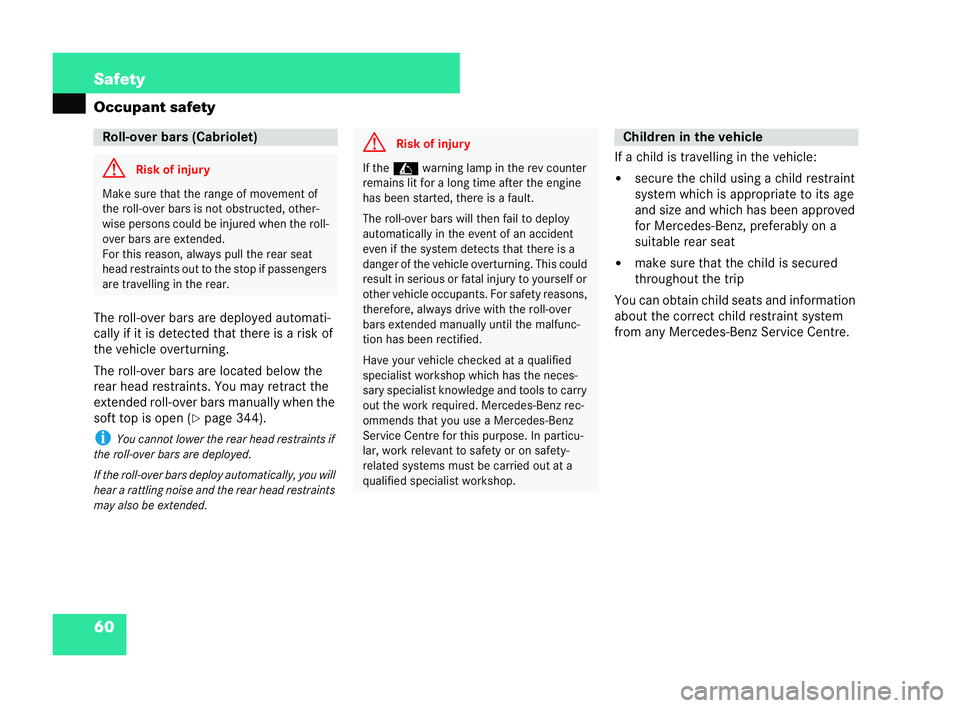
60 Safety
Occupant safety
The roll-over bars are deployed automati-
cally if it is detected that there is a risk of
the vehicle overturning.
The roll-over bars are located below the
rear head restrain ts. You may ret ract the
extended roll-o ver bars manually when the
soft top is open ( �=page 344).
i You cannot lower the rear head restrai nts if
the roll-over bars are deplo yed.
If the roll-over bars deplo yau tomatically, you will
hear a ra ttling noise and the rear head restraints
ma y als obe ex tended. If a child
istravelling in the vehicle:
�! secure the child us ing a child restraint
system which is appropriate to its age
and size and which has been approved
for Mercedes-Be nz, preferably on a
suitable rear seat
�! make sure thatthe child is secured
throughout the trip
You can obtain child seats and informat ion
about the correct child restraint system
from any Mercedes-Benz Service Centre. Roll-over
bars (Cabriol et) G
Risk of inju ry Mak
esure that the range of movement of
the roll-over bars is not obstructed, other-
wise persons could be injured when the roll-
over bars are extended.
For this reason, always pu ll the rear seat
head restraints out to the st opif passengers
are travelling in the rear. G
Risk of injury If the
\ warning lamp inthe rev counter
remains lit for a long time after the engine
has been started, th ere is a fault.
The roll-over bars will then fail to deploy
automatically in the event ofan accident
even if the systemdetects that there is a
danger of the vehic leov erturning. Thi scould
result in serious or fata lin ju ry to yourself or
ot her vehicle occupan ts.For safety reasons,
therefore, alwa ysdrive with the roll-over
bars extend edmanually until the mal func-
tion has been rectified.
Have your vehicle checked at aqualified
specialist workshop which has the neces-
sa ry special ist knowledge and too lsto carry
out the work required. Mercedes-Benz rec-
om mends that you use a Mercedes-Benz
Service Centre for this purpose. In particu-
lar, work rel evant to safety or on safety-
related syste msmustbe carried out at a
qualified specialist workshop. Childre
n inthev ehicle 209en_d2.boo Seite
60Diens tag, 25 .Mai 2004 7:26 19